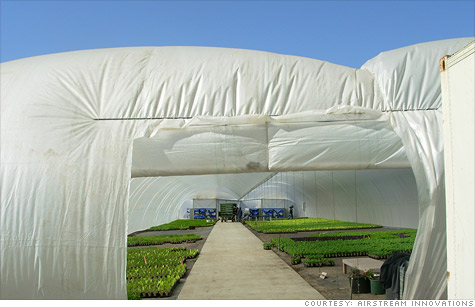Search News

Airstream Innovations' inflatable greenhouse has a built-in breeze.
OCEANSIDE, Calif. (CNNMoney) -- From the outside, it looks like a crash-landed blimp. On the inside, it feels like a wind tunnel. For inventor David Chelf, this strange structure -- a high-tech greenhouse with no skeleton, whose lightweight skin is held aloft on breezes from giant fans -- looks like the future of agriculture.
"I knew nothing could grow without airflow," Chelf explains. "And I thought if I could work with natural forces, like the wind, maybe I could create a structure that held itself up with very little energy."
Chelf, the founder of Airstream Innovations, derived his unusual greenhouse from a single principle: plants grow healthier and more productively in moving air. He prefers a gentle, three-miles-per-hour wind, which he says is perfect for helping moisture evaporate from plant leaves without dehydrating them.
When leaves are too wet, diseases and fungus can take hold. When they are too dry, photosynthesis slows or stops altogether. The right amount of moving air makes crops grow more efficiently, he says, adding that his organic strawberry plants use one-third the water and produce five times the berries compared to those grown in fields. A peek inside one of Chelf's greenhouses during a recent visit revealed rows of strawberry plants heavy with red, ripe fruit. On closer inspection, the strawberries tasted as sweet and delicious as they looked.
Chelf's greenhouses use high-volume fans that require little outside power because they harness the wind: "I realized I could direct that inside, rather than wasting a lot of energy resisting it," he says.
Made of heavily reinforced plastic, his greenhouse is about 33 feet wide and 330 feet long, with a tower for air intake at one end. The upper half of the tower has flaps that open inward, funneling wind to a pair of fans below, which reduces the power needed to keep them spinning. A gauzy netting around the fans catches insects sucked in from the outside.
In cold weather, the incoming wind can be slowed to a trickle, allowing the air to be heated before it blows into the greenhouse. In times of extreme heat, air gets cooled the same way it's done in traditional greenhouses: by introducing mist and letting it evaporate, or by using evaporative cooling pads.
Armstrong Growers, which sells flowering plants to hotels, amusement parks and other commercial customers in southern California and Nevada, uses one of Chelf's greenhouses for organic growing in its San Juan Capistrano, Calif., location.
"We call it our bubble house," says James Russell, Armstrong's vice president. "We find there are no insects, which is super-important when you're growing organically, and we've seen reduced disease. There's just nothing else like it on the market."
Richard J. Gladon, an associate professor of horticulture at Iowa State University who specializes in greenhouse design and management, also says Airstream's creation is unique. Although Gladon doesn't think any system can completely eliminate disease or insects, he says the fan-inflated greenhouse "looks like a good, inexpensive way to start growing."
An Airstream Innovations greenhouse covers about an acre of land and costs $120,000 installed, which includes fans, the air intake tower and an automatic ventilation control system. Over the last two years, Airstream Innovation's sales have totaled about $1 million. The company has two full-time and three part-time employees.
Chelf's ties to the greenhouse business go back decades: He had almost finished a Ph.D. in physics in 1990 when he quit to build a greenhouse with a friend on 10 acres in the Mohave Desert. After the two parted ways in 1996, Chelf worked for a salad grower in Silanas, Calif., and developed a system to shade the plants with low, wire-hoop arches covered in cloth. In 2005, he began growing organic strawberries in a greenhouse he built in Ranchita, Calif., under the brand name Wicked Wilds, and sold them to high-end restaurants in Southern California. He continued experimenting with greenhouse design, ultimately developing one that became the basis for Airstream Innovations.
One of Chelf's challenges has been getting growers to follow his operating rules.
One would-be customer in Sonora, Mexico, who tested the greenhouse mistakenly believed the door needed to be closed to keep the structure standing. With the door sealed, airflow slowed to almost nothing, nearly killing the crops inside. Another customer pried the exhaust open when a hurricane was on its way, decreasing the pressure inside. The under-pressurized greenhouse collapsed in the subsequent storm.
"It's been a great learning experience, seeing the things that can go wrong," Chelf says. He spent the last year making the greenhouse "idiot-proof."
Stan Cox, a senior scientist with The Land Institute in Salina, Kan., a non-profit organization that conducts breeding and ecological research for sustainable growing, says he's seen ideas similar to Chelf's in other forms and places, but never assembled in this way.
"His ideas are new to greenhouse use, and he's found a way to organize it, package it and market it," Cox says.
Chelf acknowledges that he didn't invent inflatable structures or ventilation, but he's implemented them in a novel way to make his greenhouse a unique and affordable option for growers. For evidence of how well it works, he points to those strawberries: "The proof," he concludes, "is in the eating." ![]()